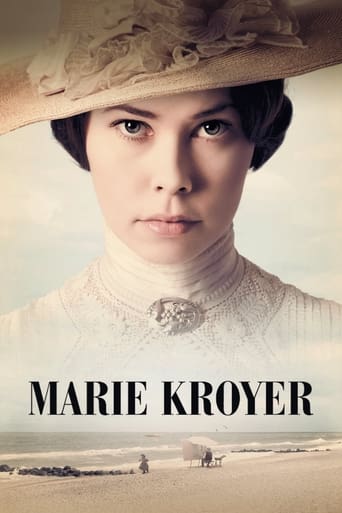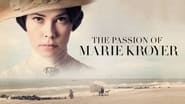Kirpianuscus
a trip in atmosphere of end of century in Danmark. a case. delicate details. good acting. inspired images. and the absence of roots. in fact, a kind of drawing, seductive, inspired, proposing a family drama, remembering another versions of Madame Bovary or Anna Karennina, work of a remarkable director, good occasion for Birgitte Hjort Sorensen to reflect her art but losing the essence of the solitude of characters, defining, more, the social impact of decisions, ignoring the step to more than a beautiful film . the music, the costumes, the delicate construction of the lead characters traits are really admirable. descending in the heart of a world, it preserves the flavor of a period. the characters are symbols and that fact transforms Marie Kroyer in a nice experience for viewer.
Armand
the sensitivity, the atmosphere, the music,the costumes and inspired acting. the mixture of ash and hope after its end. the virtue to be fresco of a society more than portrait of a life.Birgitte Hjort Sorensen does a great job as lead character and the game of nuances exploration, the science for transformation of detail are the good points for success of a touching film who is far to be remarkable but remains a nice experience. a film about woman's condition, about art and about the family , it has a special form of charm who reminds more than presents. adaptation of a novel, it is a form of descending in the heart of a world. with high precision, with beautiful care. and that could not be a real surprise. only mark of a great director return.
James Hitchcock
Peder Severin Krøyer (1851-1909) was one of the great figures of the so- called "Golden Age" of Danish painting in the nineteenth century. Although Krøyer suffered from mental illness towards the end of his life, this is not generally reflected in his paintings which are marked by a gentleness and serenity as well as by his skillful handling of light. Krøyer's wife Marie (1867-1940) was a famous painter in her own right, although this filmed biography concentrates less upon her art than upon her emotional life. It depicts the disintegration of her marriage to the troubled Krøyer (referred to here by the Christian name "Søren") and her growing attraction to, and later her affair with, the Swedish composer Hugo Alfvén. (Alfvén remains a well-known figure in Scandinavia, although elsewhere he is mostly remembered for a single work, his "Midsummer Vigil", which remains in the mind if only for the suspicious resemblance of one of its themes to the comic song "Down in Demerara"). The film is not entirely historically accurate; in reality, for example, Alfven was to become Marie's second husband after her divorce from Krøyer, but in the film he is shown as unwilling to marry her. The story, a standard tale of emotional angst among the late Victorian/Edwardian bohemian classes, is nothing out of the ordinary. (It might have been more interesting had it concentrated more on Marie's development as an artist). There are good acting performances from Søren Sætter-Lassen as the tormented Krøyer and the luminously beautiful Birgitte Hjort Sørensen as Marie, but what sets the film apart is its visual beauty. It was made in what in Britain would be called the "heritage cinema" style, with much emphasis on the recreation of period detail. "Heritage cinema" is sometimes thought of as a quintessentially British genre, but there have been a number of fine examples from continental Europe, including Denmark. Others from that country include Gabriel Axel's "Babette's Feast" (perhaps the best-known), the recent "A Royal Affair" and "Pelle the Conqueror", which like "Marie Krøyer" was also directed by Bille August. The atmosphere of this film, however, is quite different to that of "Pelle", an austere tale of working-class life. August here seems to be aiming at recapturing the serene atmosphere of Krøyer's paintings. Much of the film was shot on location on Skagen, the sandy promontory at the northernmost tip of the Jutland peninsula which features in many of the paintings of Marie and Peder Severin Krøyer. (The two were part of a group known as the "Skagen Painters"). It reminded me of "The Bridge", a film about the life of Krøyer's British contemporary Philip Wilson Steer, who painted in a similar style. (Both men were fond of paintings showing girls or women walking along a beach). Both films may be little more than standard tales of bohemian life, but both are undoubtedly beautiful to look at. 7/10
Sindre Kaspersen
Danish screenwriter, cinematographer and director Bille August's fourteenth feature film which was written by screenwriter Peter Asmussen, is a free interpretation of a biographical novel from 1999 by Danish author Anastassia Arnold called "Balladen om Marie". It premiered in Denmark, was shot on locations in Denmark and is a Denmark-Sweden co-production which was produced by producers Signe Leick Jensen and Karin Trolle. It tells the story about a painter named Marie Krøyer who lives in Skagen, Denmark with her husband named Peder Severin Krøyer who is an internationally renowned artist and their daughter named Vibeke. Distinctly and subtly directed by Danish filmmaker Bille August, this finely tuned and biographical fictional tale which is narrated mostly from the main character's point of view, draws a moving portrayal of a challenging marriage between two 19th century painters. While notable for its distinct and naturalistic milieu depictions, sterling production design by Danish production designer and art director Jette Lehmann, cinematography by Danish cinematographer Dirk Brüel, costume design by Danish costume designer Manon Rasmussen and use of light, this narrative-driven story depicts an empathic study of character and contains a great score by composer Stefan Nilsson.This literary and romantic period drama which is set in a town in Northern Denmark during the beginning of the 20th century and where a woman's relationship with her talented though mentally ill husband leads her to a meeting with a Swedish composer named Hugo Alfvén, is impelled and reinforced by its cogent narrative structure, subtle character development and continuity, natural characters, efficiently understated acting performances by Danish actress Birgitte Hjort Sørensen, Swedish actor Sverrir Gudnason and the fine acting performance by Danish actor Søren Sæter-Lassen. A quiet, eloquent, reflective and compassionate homage.




